
Assignment on Business Management: Quick Guide

What is Business Management Assignment
College curriculums are loaded with unfamiliar subjects, and students often feel lost. The first assignments are usually the hardest to get done, and a little help would be nice. If you are a beginner facing this challenge and are asking all around 'what is business management' or how it differs from business administration, you have come to the right place. This quick guide will explain the basics of the management of business and will provide topics of business management essays.
To put it simply, business management is a process of planning, organizing, directing, and controlling the organizational resources to achieve the company's objectives. While business administration concentrates on the organization's day-to-day operations, business management focuses on the overall process.
Business management is vital for a successful business. A business manager's job is to make strategic decisions, allocate resources, hire the best employees, and ensure the company meets its business objectives.
A business management assignment helps students demonstrate their ability to apply theoretical knowledge to real scenarios and prepare them for future challenges. While the structure of the assignment is not foreign to experienced students, it covers a wide range of topics. It could involve operations management, financial and human resources management, organizational behavior, etc.
In the following chapters, you will find useful tips, a formal structure, and a general outline of a business management essay. Down below, there is a list of essay topics you could write a magnificent essay about. To clarify things, here is a business assignment sample essay. Our college essay writing services will provide a business essay crafted to meet the highest standards of your university.
How to Write a Business Assignment: Helpful Tips
Even though every essay structure and general outline resembles one another for each type, there are still many intricate details that you should consider when writing a business management assignment.
Let's move on to discuss constructing an impressive business paper without wasting time making mistakes. The following guide will save you the trouble of extensive research on how to polish an academic paper and help you reach the academic success you deserve.
If you don't have much free time on your hands, our exceptional custom essay writing service is also a great option. Let us know what is due, and we will deliver unforgettable reports on business management.

Choose Relevant Business Management Topics
Start by implementing a general to a specific approach. Think about the areas of your expertise and how it links with the business assignment. A topic you feel comfortable writing will help you construct a high-quality and meaningful research paper.
Writing about the topics of business you feel passionate about will make the process more engaging and enjoyable. Consider your audience, and make the topic meet their needs. This will help you write an informative and engaging paper. Be relevant. Stay up to date with trending topics of business management. Choose a topic about an important issue and provide new perspectives or even a solution. Filling in the existing gaps will help your essay stand out.
Narrowing down the scope is always a good idea. The specific topic will make your work more manageable and keep you focused. A broad topic is always difficult to cover, but narrowing it down too much can limit your research options. Thus, balance is the key!
Maintain Your Management Assignment Structure
Maintaining the structure of the assignment is crucial. Make sure to keep your ideas coherent and your essay easy to follow. Whether you are writing about international business management or organizational structure, the most important thing is simply communicating your ideas to the readers.
Start by following the course guideline. Make sure you understand every component. Usually, professors give out this kind of map to determine the structure, format, and length of the management of business assignments.
Before you start writing, create an outline. Organize your thoughts and ideas and stay on track. Use headings and subheadings to break up your assignment into sections. Start with a strong introduction and an easy-to-digest thesis statement. Follow it with comprehensive body paragraphs. Here you can provide your arguments, show other people's work, and communicate with the audience about the problems you've discovered. Use transitional sentences to connect your ideas and eventually to the bigger picture. Finally, write a powerful conclusion that ties everything up. Showcase your ability to link various arguments to one another.
Following our guidelines will bring clarity and coherence to your writing. Well-structured and easy-to-follow essays always get positive feedback from their readers.
Analyze Topics of Business, Don't Repeat
Analyzing business paper topics can get tricky, especially for beginners who have to develop their writing style. Chances are you will repeat the same argument several times to make it look more convincing. But answering the question 'what is business management' several times with different words will only make your paper look unprofessional.
It's tricky, but there are ways to avoid repeating the arguments. Do the prior research. Acquiring knowledge will expand your horizon, and you won't feel the need to repeat the same sentence couple of times. Create the general outline. Knowing the order of your essay elements will help you avoid restating the same information twice.
Besides the general outline, it's a good idea to list all the key points and prioritize them. This way, you will cover every important detail in your essay. Last but not least, consider alternative perspectives. If you incorporate opposing viewpoints, you will enrich the paper and show off your writing skill level.
Provide Rationale for Your Business Assignment
It is trivial, but for safety reasons, let's point out: an argument without supporting evidence is not valid. The same goes for the topics of business management essay. You must provide a rationale for every stage of the essay.
Being able to provide supporting evidence demonstrates strong research abilities. Writing a well-reasoned essay requires thorough research. Providing rationale and citing sources in the assignment shows that the writer has done their best. Besides looking professional, it will be easier to convince the reader about the credibility of your argument if they can see the reasoning behind it. If you can explain why you think what you think, it shows that you have considered opposing viewpoints. Critical thinking is one of the most important aspects of the writing process.
Writing essays about the management of business takes extensive research. If the deadline is too close and there is not enough time to master the art of writing, you can go to the website and check out our custom research papers writing service . Our team of professional writers is always here to help you.
Use Formal Language in Your Business Assignment
In business, academia, or any other professional setting, we use formal language. It strictly adheres to the rules of grammar, tone, and vocabulary.
Formal language helps to establish a professional tone in A management assignment which supports creating a positive impression on the reader. Using formal language also increases the clarity of the arguments. Formal language is more precise, which can help avoid ambiguity and confusion.
No matter which business management topic assignment you write, having a respectful relationship with your audience is crucial. Formal language and correctly chosen vocabulary can take you a long way. It shows respect to the reader and the topic also.
Thus, you must avoid using slang, vocabulary unsuitable for the audience, contractions, and other unprofessional language or tone forms. And if you are reading all these, you are thinking, 'why can't somebody else write an essay for me ,' visit our website, and your wish will become a reality in no time. Get top-notch essays tailored to your specific requirements.
Need a Great Essay?
Get top-quality essays written by professionals today!
Business Management Topics
Mastering the art of constructing an impressive essay is only one-half of the job. First of all, you need an engaging topic. Our team has prepared a comprehensive list of business management topics to write about. From operations to business process management, explore a list of topics covering a wide range of fields, choose the one that excites you the most, and start implementing the freshly acquired knowledge.
International Business Management Topics
Our experienced writers have gathered the 20 most engaging topics about international business management. Explore the list and find the most attractive one:
- Exploring management concepts in international business
- Cross-cultural challenges in achieving Organizational goals
- The challenges of the first line managers in international organizations
- Key strategies for managing international business operations in an efficient and effective manner
- Maximizing international business success through effective human resource management strategies
- Navigating global business challenges through effective management of cultural intelligence
- Effective leadership strategies for international business management
- Cross-cultural communication as an essential part of international business management
- The link between happy employees and successful international business management
- Maximizing global business performance through effective staff managers
- Leveraging various resources for competitive advantage
- Understanding the universal phenomenon of cross-cultural communication challenges
- Foreign direct investment and risks for international businesses
- Sustainability in international business
- Challenges of corporate governance in international businesses
- The role of ethical leadership as an essential part of international business management
- Developing a high degree of cross-cultural competence
- Managing global value chains: integrating all the activities in international business management
- The importance of cultural awareness in international business management
- The role of self-confidence in international business management
Operations Management Assignment Topics
Below you will find the most relevant and moderns operations management assignment topics:
- Enhancing Organizational Performance through Effective Operations Management and Managerial Skills
- The role of organizational chart in effective operations management
- The impact of executive functions on operations management
- The role of operations management in achieving success at a shareholder meeting
- The importance of understanding human behavior in operations management
- Leveraging consumer insights based on market research
- Optimizing group dynamics in operations management
- Leadership and strategies of general managers in operations management
- Planning effectively: best practices for operations management
- Tools, techniques, and approaches for a good knowledge base in operations management
- How to manage an organization effectively: operations management strategies
- The role of operations management in organizational development
- Achieving efficiency and productivity through simple form and process
- The role of independent decision-making in operations management
- Management theories: How to plan effectively toward organizational success
- Optimizing human activities for the entire organization's success
- Streamlining operations management for a particular job: important strategies for effectiveness
- From plans decided to action implemented: the importance of effective operations management
- Provide guidance for upper management: strategies for leadership and direction
- Balancing technology and human beings for global success
Business Process Management Topics
Explore 20 more topics about business process management:
- Strategies for implementing effective business process management principles across the entire organization
- The role of human effort and organizational structure in achieving operational excellence
- How successful managers utilize basic principles for achieving operational excellence
- Interplay between management principles and executive function in driving business process
- Achieving synergy between top management and other employees for improved operational efficiency
- The crucial role of company leadership in aligning objectives and strengthening decision making
- A critical analysis of management theories: exploring the role of functional managers in achieving goals
- Optimizing the management process to achieve organizational goals
- Effective business process management consists of strategic allocation for company growth
- How to manage challenges created by leadership and top management
- Optimizing business process management through collaborative efforts between top managers and the best employees
- Crucial managerial skills: Optimizing processes through nurturing talent and celebrating human efforts
- The role of the functional manager in talent acquisition and optimizing human resource management
- Why business process management involves determining the journey, not just the destination
- Aligning employee decision-making with business objectives
- How process-centered leadership empowers organizations to manage change
- Process improvement through agile methodologies
- The evolution of process management thought
- The role of information technology in business process management
- The impact of business process management on customer satisfaction and retention
Additional Interesting Topics of Business
If you can choose from a wide range of topics, this list is for you. Impress your professor with an intriguing topic assignment:
- Measuring the ROI: Key metrics and techniques for demonstrating value to stakeholders
- Effective change management: how to implement and adapt
- Digital transformation in business management
- Strategies for handling and overcoming business crises
- Strategies for reducing environmental impact and promoting social responsibility
- Best practices and emerging trends for effective online branding
- Strategies for driving innovation and creating a culture of creativity
- Managing human resources in small business
- Strategies for managing cash flow, budgets, and investments
- The importance of market research and analysis for effective business management
- Using game mechanics to improve employee performance and engagement
- Strategies for effective time management and priorities in a busy workplace
- Strategies and tactics for successful business deals
- Emerging trends in remote work, automation, and AI
- Benefits and best practices for reducing stress and improving productivity
- Creating a workplace culture that fosters happy employees
- How understanding human behavior can inform business decision making
- Is servant leadership a new paradigm for effective business management?
- Techniques for handling uncertainty and complexity in an organization
- The role of entrepreneurial mindset and creativity in business success
Business Assignment Sample Essay
In the next section of the article, you will find a sample business management essay to help you understand how to structure and write a successful business assignment. Read through it carefully and take notes on the techniques used.
Further Academic Help
Are you struggling to come up with an assignment on management topic? Let us help you! Our online assignment writing service provides a comprehensive list of essay titles across various subjects to choose from, whether it's topics of business management or history assignment.
Don't stress yourself out; rely on our expertise to deliver outstanding results. Contact us today and take advantage of our reliable and affordable writing services.
Struggling with Your College Essay?
Order now and experience the best essay-writing service availabl
Related Articles
%20(1).webp)
BUS101: Introduction to Business
Course introduction.
- Time: 62 hours
- College Credit Recommended ($25 Proctor Fee) -->
- Free Certificate
Course Syllabus
First, read the course syllabus. Then, enroll in the course by clicking "Enroll me". Click Unit 1 to read its introduction and learning outcomes. You will then see the learning materials and instructions on how to use them.
Unit 1: The Context of Business
This unit covers the basic concepts that give context to a business. We explore economic and historical information governments use to make decisions, which provides a foundation for future decision-making. You will learn about productivity, the business cycle, the impact of business on society, economic trends and policies, and elements of global business. We will examine the financial meltdown of 2008, including the government bailout of AIG and General Motors, and the collapse of Lehman Brothers, which provide teachable moments in economic policy and business cycles.
Completing this unit should take you approximately 15 hours.
Unit 2: Entrepreneurship and Legal Forms of Business
In this unit, we explore various forms of ownership (sole proprietorship, partnerships, and corporations) that affect how businesses are taxed, how profits are distributed, and what regulations must be followed. The form of ownership you choose corresponds to the growth, taxation, and future of your company. We also examine some techniques business owners use to analyze profitability. We review the characteristics of successful entrepreneurs, how small businesses impact the economy, and the role of the Small Business Administration in the United States.
Completing this unit should take you approximately 10 hours.
Unit 3: Marketing
Marketing encompasses more than simple advertising and selling. It describes the activity businesses engage in to create, communicate, deliver, and exchange their products to their customers, clients, partners, and society. Business owners not only aim to provide customers with the goods and services they want and need, but they also need to convince them to make a purchase and come back for more. It involves the product, price, distribution, and promotion in the form of advertisements, publicity, public relations, and sales promotion. We will explore e-commerce, e-business, and the use of social media marketing.
Completing this unit should take you approximately 9 hours.
Unit 4: Accounting, Finance, and Banking
Every day, business owners make financial decisions that will affect every phase of the business operation, such as payroll, cash flow, and projecting future growth. A thorough understanding of accounting and financial management allows business owners to find the best sources and use of funds. For example, you can derive an accurate measure of the health of your business from the income statement, balance sheets, and financial ratios. We investigate financing options, how to analyze credit, and the time value of money. We also examine how banks, such as the U.S. Federal Reserve Bank, affect the ability of businesses to obtain financing.
Completing this unit should take you approximately 12 hours.
Unit 5: Management
The management practices that a business adopts will inform how well it can achieve its goals and respond to changes in the workplace. For-profit and nonprofit companies achieve their goals through the four steps of management: planning, organizing, controlling, and leading. Technical, conceptual, and interpersonal skills are essential to the management process. It also involves using human, financial, and informational resources. In this unit, we explore how successful business management requires teamwork, communication, creating a clear corporate mission and culture, following good business ethics, and committing to social responsibility.
Completing this unit should take you approximately 16 hours.
Study Guide
This study guide will help you get ready for the final exam. It discusses the key topics in each unit, walks through the learning outcomes, and lists important vocabulary. It is not meant to replace the course materials!
Course Feedback Survey
Please take a few minutes to give us feedback about this course. We appreciate your feedback, whether you completed the whole course or even just a few resources. Your feedback will help us make our courses better, and we use your feedback each time we make updates to our courses. I f you come across any urgent problems, email [email protected].
Certificate Final Exam
Take this exam if you want to earn a free Course Completion Certificate.
To receive a free Course Completion Certificate, you will need to earn a grade of 70% or higher on this final exam. Your grade for the exam will be calculated as soon as you complete it. If you do not pass the exam on your first try, you can take it again as many times as you want, with a 7-day waiting period between each attempt. Once you pass this final exam, you will be awarded a free Course Completion Certificate .
Saylor Direct Credit
Take this exam if you want to earn college credit for this course . This course is eligible for college credit through Saylor Academy's Saylor Direct Credit Program .
The Saylor Direct Credit Final Exam requires a proctoring fee of $5 . To pass this course and earn a Credly Badge and official transcript , you will need to earn a grade of 70% or higher on the Saylor Direct Credit Final Exam. Your grade for this exam will be calculated as soon as you complete it. If you do not pass the exam on your first try, you can take it again a maximum of 3 times , with a 14-day waiting period between each attempt.
We are partnering with SmarterProctoring to help make the proctoring fee more affordable. We will be recording you, your screen, and the audio in your room during the exam. This is an automated proctoring service, but no decisions are automated; recordings are only viewed by our staff with the purpose of making sure it is you taking the exam and verifying any questions about exam integrity. We understand that there are challenges with learning at home - we won't invalidate your exam just because your child ran into the room!
Requirements:
- Desktop Computer
- Chrome (v74+)
- Webcam + Microphone
- 1mbps+ Internet Connection
Once you pass this final exam, you will be awarded a Credly Badge and can request an official transcript .
Saylor Direct Credit Exam
This exam is part of the Saylor Direct College Credit program. Before attempting this exam, review the Saylor Direct Credit page for complete requirements.
Essential exam information:
- You must take this exam with our automated proctor. If you cannot, please contact us to request an override.
- The automated proctoring session will cost $5 .
- This is a closed-book, closed-notes exam (see allowed resources below).
- You will have two (2) hours to complete this exam.
- You have up to 3 attempts, but you must wait 14 days between consecutive attempts of this exam.
- The passing grade is 70% or higher.
- This exam consists of 48 multiple-choice questions.
Some details about taking your exam:
- Exam questions are distributed across multiple pages.
- Exam questions will have several plausible options; be sure to pick the answer that best satisfies each part of the question.
- Your answers are saved each time you move to another page within the exam.
- You can answer the questions in any order.
- You can go directly to any question by clicking its number in the navigation panel.
- You can flag a question to remind yourself to return to it later.
- You will receive your grade as soon as you submit your answers.
Allowed resources:
Gather these resources before you start your exam.
- Blank paper
What should I do before my exam?
- Gather these before you start your exam:
- A photo I.D. to show before your exam.
- A credit card to pay the automated proctoring fee.
- (optional) Blank paper and pencil.
- (optional) A glass of water.
- Make sure your work area is well-lit and your face is visible.
- We will be recording your screen, so close any extra tabs!
- Disconnect any extra monitors attached to your computer.
- You will have up to two (2) hours to complete your exam. Try to make sure you won't be interrupted during that time!
- You will require at least 1mbps of internet bandwidth. Ask others sharing your connection not to stream during your exam.
- Take a deep breath; you got this!

Want to create or adapt books like this? Learn more about how Pressbooks supports open publishing practices.
Book Title: Principles of Management
Author: [Authors removed at request of original publisher]

Download this book
- Digital PDF
- Pressbooks XML
- OpenDocument
Book Description: Principles of Management teaches management principles to tomorrow’s business leaders by weaving three threads through every chapter: strategy, entrepreneurship and active leadership. For questions about this textbook please contact [email protected]
Book Information
Book description.
Principles of Management is adapted from a work produced by a publisher who has requested that they and the original author not receive attribution. This adapted edition is produced by the University of Minnesota Libraries Publishing through the eLearning Support Initiative. For questions about this textbook please contact [email protected]
Principles of Management Copyright © 2015 by University of Minnesota is licensed under a Creative Commons Attribution-NonCommercial-ShareAlike 4.0 International License , except where otherwise noted.

Want to create or adapt books like this? Learn more about how Pressbooks supports open publishing practices.
1 Introduction to Management
Learning Objectives
The purpose of this chapter is to:
1) Give you a basic understanding of management and its importance
2) Provide a foundation of the managerial functions of planning, organizing, leading, and controlling
Introduction to Management
Management is not a hard science. Unlike chemistry or algebra where a right answer (often) exists, management is fluid, and subjective, and there are divergent perspectives on how to employ its principles. But what exactly is management? Most scholars have variations of the same definition that include a utilization of resources to achieve a goal. Lussier (2021) defines a manager as “the individual responsible for achieving organizational objectives through efficient and effective utilization of resources” (p. 3). The problem with this definition is that it implies that a manager has to be both efficient and effective, which eliminates the possibility of having a bad manager. Each of us can probably contradict this definition by providing an example from our personal past. However, this definition contains the basic elements of using resources to pursue goals.
An early management scholar, Mary P. Follett characterized management as “the art of getting things done through the efforts of other people” (Graham, 1995). This definition implies both pursuing goals (getting things done) and utilizing resources (predominantly through people). However, this too is missing an element, that of the organizational context. An important consideration for understanding management is that the term organization simply refers to “a collection of people working together to achieve a common purpose” (Shermerhorn, 2013, p. 11). This means an organization could be anything from your high school volleyball team to church or a corporation. Including the term “organization” in the definition leaves open the possibility that management can be practiced in each of these settings, and broadens our use of the term management. A comprehensive definition for management then, would be the pursuit of organizational goals through the use of organizational resources (Bateman & Snell, 2013). Pursuit implies a chance of failure and organizational gives us a context. This begs the question – how can we become effective at the pursuit of goals, or become more efficient in our use of organizational resources? Being good at management requires an immense focus on both of these ends, and we can achieve this through the process of the planning, organizing, leading, and controlling functions of management. These functions serve as the basis for the rest of the textbook because they are the essential tools we use to manage organizations. Most of the context and examples for this book focus on the corporate use of management. However, you should meet the concepts where you are in your professional or academic career – apply the principles to the context of your life, master the four functions for what you are doing now so that you can scale them to much bigger managerial endeavors later.
Management is not New
A broad understanding of management as resource utilization focused on a goal gives us a wide scope of situations and contexts in which to practice it. For example, the Crow Indians employed a complex strategy to harvest an entire herd of buffalo by driving them off a cliff. To funnel the herd to the lane leading up to the cliff they used a decoy (a hunter donned in a buffalo calf robe imitating a lost calf), incense to smoke them towards the lane, or rock piles to guide them to the lane (Nathan, 2018). If we apply the basic principles of management in this context we can see these hunters used resources (rocks, incense, knowledge and tradition) to pursue a goal (procurement of food, tools, and clothing the bison afforded them).

At its core, this imperial supply chain used the same approach to achieve success th at a teenager might use in a playing video games. If he rallys his friends after school in a game of Call of Duty to defeat their online opponents, he might also be considered a manager. He uses his experience and knowledge of gameplay as well as weaponry within the game to pursue his goal of competitive domination.
These examples demonstrate that management is multifarious, and not at all a recent phenomenon. Yet, when we hear the term management , most of us probably conjure an image something like that of a corporate vice president implementing a marketing strategy to meet quarterly sales goals. The irony is that the corporate manager is utilizing the same tools as those of the native hunter, Spanish fleet admiral, and sophomore gamer. Management is both universal and ubiquitous in that we all use variations of its elements.
The Four Functions of Management
The management process by which we pursue goals includes planning, organizing, leading, and controlling. These are “ the how ” a manager pursues organizational goals, and are universally known as the four functions of management. They stem from the work of a French mining administrator, Henri Fayol, who first identified management as a practice that could be improved through the use of five functions – planning, organizing, commanding, coordinating, and controlling. Since he published his work in 1916, we have decided that leading people through motivation and incentivization works much better than telling them what to do (e.g. commanding and coordinating). We use the term leading instead of these practices. Chapter 2 on the history of management will provide some insights regarding this change. Nonetheless, he gave us a place from which to start.
Even if you have never stepped foot in a corporate office, or held the title of manager at your local Dairy Queen, you have no less used the functions of management in your personal pursuits. A relevant example would be the process by which you manage your personal budget.
Reflection: Are you already a manager?
Think about your personal or family budget for a moment, and answer the following questions:
1) Do you have your budget written down somewhere, or in an excel spreadsheet?
2) What are your financial goals?
3) How much do you put in savings, charity, and monthly expenses?
4) Where does your money come from (a job, your parents, a hobby, your spouse)?
5) If you have a budget shortfall during the month, what do you do?
6) How do you keep track of expenses to ensure your bank account remains in the black?
If you answered yes to question #1, then you are already engaged in the management function of planning. You know where your money is being spent. The same holds true for your financial goals. If you want to leave college debt free, save for a down payment on a house, or go on an unforgettable spring break trip, you have defined your organizational objective! Where you put your money is a function of how you manage your resources. This organizing function is presumably in line with your financial goals. For example, if you want to save for a down payment, you need to actually allocate your resources (income) to a savings account. Moreover, where your money comes from is also the source of your organizational resources. A budget shortfall might require you to employ the leading function of management. The essence of leading is motivating other people to align with your plan. What do you do if you need to pay bills, but don’t have the money? Perhaps you ask your parents for a loan (need to sell this idea to them), or you might need to negotiate with a co-worker to let you take on extra shifts (show them what’s in it for them in return), or it might be the reality that you need to sell something to make ends meet by selling something (in which case selling requires you to inspire someone else to see value in what you are selling). Leading might also entail convincing someone else in your circle to get on board with your gameplan (like a spouse, or sibling). Finally, keeping track of your expenses to ensure solvency and pace with your goals is the core of the controlling function. Do you keep receipts and check them against your online account expenses? Do you update your spreadsheet after your bill automatically debits from your account? Do you get an email notifying you have a low balance and are in risk of overdraft charges? Each of these methods are ways to monitor your progress and decide if you need to make a change (short term or long term).
If you reflect on this example of your personal budget, or you worked to achieve a personal or team goal, you will likely conclude that you are already a manager. This wide application of managerial thinking means that if you can master its principles on your personal scale, you can then amplify its use when you need to use it on a large scale. Get good at leading your class project, organizing your club fundraiser, or helping your team win a conference championship, and you will later be able to magnify the scale to lead a marketing department, or corporate merger, and even diplomatic negotiations as a prime minister.
Mastering the four functions will allow you to apply the function of planning on a more complex stage such as evaluating the internal and external environments of your organization. Using this analysis you can create an effective game plan to formulate a sustainable competitive advantage. Developing an organizing skillset will allow you to propose a structure for your team that incorporates cross functional members and ways of thinking. It will allow you to identify and recommend resources needed to pursue your plan. Honing your leading skillset will afford you the capability to motivate your organizational stakeholders to partake in your strategy, and force you to consider the ethical implications of your actions. Finally, implementing effective controlling allows you to check progress towards your goals and to recommend changes if you need to get on track.
Planning is the systematic process of making decisions about goals and activities the organization will pursue (Bateman & Snell, 2013). To make a decision about the direction of an organization, the planning phase must begin with analyzing the environment. Without a solid understanding of the context, the manager would have no basis to provide future direction. The context gives a manager a point of reference for improvement, opportunity, and learning from past mistakes. For this reason, the planning function should begin with analysis. This analysis should consider both the internal factors such as culture, values, and performance of team members as well as the external factors such as competitive environment, legal regulations, economy, technology, social values, and demographics.
The second component of planning is to use this analysis of the environment to build goals, activities, and objectives. For a major organization this might be the vision and mission statement of the organization. For a smaller organization this could be a year end, or season end goal. Some consider planning that point in your day or month that you step away from your desk, and think about the direction of your organization. This requires you to reflect on your organization’s past, and determine how that impacts the direction going forward.

Organizing is the process of assembling and assigning the human, financial, physical, informational, and other resources needed to achieve goals (Bateman & Snell, 2013). The core of the organizing function is leveraging the resources to align with the determined goals. Organizing human resources means first of all attracting a labor force that can help you pursue your goal. Within the organization, managing the human element means assigning tasks, delegating authority, determining a structure and hierarchy. Organizing the financial resources equates to making sure your capital is being utilized to meet goals. If an organization decides they want to have a best-in-class customer service team, they better being willing to spend the money to attract people with the disposition towards serving others, and spend money on training, or a retreat to teach the agents the skillsets they need. Marshalling physical resources focuses on the effectiveness of where you place and how you use physical assets. An executive chef might re-arrange a kitchen to improve process flow, food quality, or mitigate safety risks for example. Informational resources implies a leveraging and disseminating the organization’s knowledge in meaningful ways to achieve goals. Connecting employees to how they contribute to the financial bottom line is a way of leveraging informational resources, as is using your company’s proprietary algorithm to predict stock prices or develop new products.
Leading is stimulating high performance by members of the organization (Bateman and Snell, 2013). This function is getting members of the organization on board with your plan.
Normally, this means connecting with direct reports or teammates on a personal level. Understanding what drives individuals within the team allows a manager to design strategies around motivating, incentivizing, mobilizing, and arousing a desire to contribute.
Imagine for a minute, that you analyzed the conditions of the organization, you determined a game plan to pursue and even directed resources to step in that direction. You have successfully implemented the planning and organizing functions. In this scenario, however, you did not give consideration to how your team or organization would be involved. Do they agree with your direction? Did they have input in the process? Do they feel valued as a team member? Do they understand their role in a successful outcome? All of these questions are answered by the degree to which a manager is engaged in the leading function.
Having personal conversations, designing a bonus structure, or giving a rousing speech might all be considered leading the organization.
Controlling
Control is installing processes to guide the team towards goals and monitoring performance towards goals and making changes to the plan as needed (Batemen & Snell, 2013). Control does not always mean limited what the organization can do by having a hand in everything. We might call this micro-managing, which is control in its extreme form. Healthy control processes involve putting systems in place to make sure your organization is on track to meet the goals you established in the planning process. Planning sets standards to compare against, and the control process is the dashboard that tells whether or not you are meeting the standard. For example, a grocery store might set a goal of reducing shrink (that’s product lost to shoplifting, damage). They decide that they want to reduce their shrink loss by 50%. To achieve this plan, they will have to dedicate resources (more employees to monitor, rearrange loading dock). You already recognize that step as the organizing function. We then incentivize our employees by designing a bonus structure – i.e. if we collectively meet the goal, each employee shares in the savings. If we stop there, we would have no way of knowing if we met the goal. The control process solves this for us. The last step in the grocery store manager’s managerial approach is to have each department head report their shrink loss at the end of the shift, and aggregate those in an excel spreadsheet. In this way, the manager can see if the rearrangement of the loading dock has reduced the number of damaged canned goods that was happening under the old arrangement. The manager can make changes if they see that shrink is not improving even after hiring a greeter at the entrance.
Monitoring performance is the first step in control. After see the progress towards goals, the next step is to make changes. In this way, the control process always leads a manager back to the planning phase of management. There are only two outcomes to the control process. You are making progress towards your goal, or you are digressing in your performance. If you reach your goal, you will need to set new goals, which is the planning function. If you are not progressing towards your goal, you need to analyze the environment and determine why not. In this way the management functions are related and highly dependent upon each other, especially control and planning.
To illustrate the application of the four functions of manager, consider the various contexts in Figure 1.1. Under the personal budget, an engaged couple has decided to save for a house after getting married. The softball coach must determine how to win a conference championship, and the corporate manager is working on a strategy to improve waning sales figures.
Figure 1.1 – The Functions of Management Applied
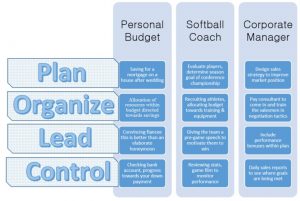
On the Importance of Studying Management
The purpose of this textbook is to provide you with firstly, a broad exploration of what management is – its elements and origins. Secondly, the purpose of this textbook is to provide you with a managerial framework you can utilize to practice management at any level of complexity. This framework emphasizes the four basic functions – planning, organizing, leading, and controlling. Most management textbooks include a wide variety of academic terms and concepts that take focus away from these four functions. Other textbooks will inundate the reader with descriptions of heuristics, focus on layers of management, or extraneous terms like the Shamrock organization that do not advance a practical understanding of management. We have designed this textbook with the four functions of management at the forefront because these elements are so critical to the foundation of everything you will do in the managerial context. This textbook provides a history of management and a chapter on ethics, but then focuses exclusively on the functions of management as the subject matter. At the completion of this textbook, you should be able to understand, recognize, and apply these four functions of management.
The four functions of management (plan, organize, lead, and control) serve as the foundation for everything else you will study in your business education. Mastering these tools at the most basic level, as well as the more sophisticated levels in classes you will take later, will best prepare you as a business professional (Dolechek et al, 2019).
Figure 1.2 – Management as the Foundation
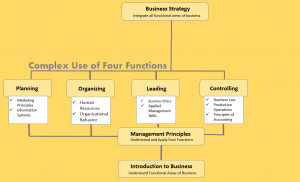
Upon completion of a management principles course, you will progress towards the applications of the four functions of management in the upper level courses. For this reason, management principles serves as a pre-requisite for most other management courses. In marketing principles you will develop an understanding of how to analyze external conditions, and a course in information systems will help you design ways to collect more information to analyze. This is the core of the planning function. In human resources and organizational behavior, you will learn the dynamics of your ever-important resource of human labor, the organizing function. In business ethics and applied management skills you work on understanding what drives people, and by association how to lead them based on that understanding. Grasping business law and production operations will give you a deeper understanding of how to monitor progress (to meet legal compliance and to test production quality for example). The entire discipline of accounting is a managerial function of control. Constructing financial statements is done for the sole purpose of determining the performance of you organization so that you can make future decisions. The capstone course of a business program is the business strategy class. In this course, students are given an opportunity to demonstrate mastery of the four functions by including all of the functional areas of business in their decision making.
A Whale of an Example
You are the city manager of a coastal Oregon city. On a quiet, rainy Tuesday, you walk into your office and put the coffee on. As you take your first sip, your administrative assistant forwards you a phone call from the parks and rec manager. “We’ve got a problem down here on the beach. The tide just left a dead humpback whale on our beach.” What do you do? What. Do. You. Do?? Now, there are several options to dealing with the dead whale. Consider the following questions:
- 1) What is your strategy for dealing with this problem? ( Plan )
- 2) What resources do you need to follow your strategy? ( Organize )
- 3) What stakeholders do you need to get on-board? ( Lead )
- 4) What steps can you take to make sure your plan is proceeding as you planned it? ( Contro l)

There are a handful of strategies we might naturally gravitate towards. The feasibility of each strategy depends on how well you employ the functions of management.
Tow the whale back to sea – A crane, tug boat, and tow cable are needed. Who might you need to include in this gameplan? The coast guard might need to be involved to discuss any pertinent regulations. A marine captain that can tell you about tides so that you can time your extraction, and insights about currents to indicate how far out you need to haul the whale once its buoyant. Should you allow a marine biologist to provide advice on what sort of ecological impact this might have (like bring in unwanted sharks or seals). How can you be sure the tow cable has enough tinsel strength to haul a bloated whale on a high friction surface like wet sand? Does the crane have the capacity to move the carcass into position to be hauled? If the whale is decaying, will the tow cable just pull through the rotten flesh?
Cut the whale up, haul it to the dump – You will need a forklift, semi-truck, and chainsaw. The first consideration here would be the logistics of pursuing this strategy. You will need to find a truck with the towing capacity to haul large chunks of the carcass off the beach. Can you ensure the weight of a loaded semi would not sink into the wet sand? How much does a semi-loaded with a whale carcass weight? You may also need to contact the county roads manager to determine if there are any bridges between the beach and the dump that have weight restrictions. What sort of protective equipment would you need for the men slicing through the whale with chainsaws? There are a few control processes that need to be put in place for this strategy to work.
Celebrate the whale – The objective of the city manager is to “deal with” the dead whale. For most, this would mean remove it somehow. For others, this might be a chance to celebrate the occasion, and establishing the experience in the culture and history of the town. To celebrate the whale, the city manager can hold a competition like car dealers do to promote their cars – have contestants place their hand on the whale and the last person to withstand touching the grotesque, slimy, and malodorous creature, somehow wins a major prize. This would require a sponsor to donate a prize (a car, a vacation) and the town can celebrate the occasion annually. If the goal is to appease the community from the existence of the whale and its stench, celebration is one strategy to pursue that end. You would need to include a biologist to determine if leaving the whale to decay after the festival would attract scavengers, and a water chemist to determine if a decaying whale creates toxicity problems for beach goers.
Blow it up! – The kid in most of us choose this option. Definitely. You might need to check with state officials to see what the protocols are on this approach. The biggest question would be how much dynamite do you need to blow up a whale, or blow it into the ocean? In Oregon, one stakeholder group you might contact is a mining company or the Oregon national guard. Both of those groups have a lot of experience calculating explosive requirements. What are the safety protocols you need in place to make sure that no one is injured? Where will you be able to source enough explosives to achieve this goal?
Use of the four functions
Each of these scenarios contain some far-fetched elements. But asking the right questions is paramount to turning any of these into a feasible strategy. You first need to decide a path, then determine your resources before getting stakeholder groups on board. For a high-risk situation like most of these solutions call for, you need to put control mechanisms in place to mitigate your risks. If you type “Oregon’s exploding whale” you can see what has become the most-watching news broadcast of all time. It shows you what happens when a city manager does not successfully navigate the situation using all four functions of management.
Critical Thinking Questions
How are the four functions of management related?
Which is the most important function of management?
Choose a historical event prior to the year 2000. Analyze the leader’s use of the four functions of management during that event.
How to Answer the Critical Thinking Questions
For each of these answers you should provide three elements.
- General Answer. Give a general response to what the question is asking, or make your argument to what the question is asking.
- Outside Resource. Provide a quotation from a source outside of this textbook. This can be an academic article, news story, or popular press. This should be something that supports your argument. Use the sandwich technique explained below and cite your source in APA in text and then a list of full text citations at the end of the homework assignment of all three sources used.
- Personal Story. Provide a personal story that illustrates the point as well. This should be a personal experience you had, and not a hypothetical. Talk about a time from your personal, professional, family, or school life. Use the sandwich technique for this as well, which is explained below.
Use the sandwich technique:
For the outside resource and the personal story you should use the sandwich technique. Good writing is not just about how to include these materials, but about how to make them flow into what you are saying and really support your argument. The sandwich technique allows us to do that. It goes like this:

Step 1: Provide a sentence that sets up your outside resource by answering who, what, when, or where this source is referring to.
Step 2: Provide the quoted material or story.
Step 3: Tell the reader why this is relevant to the argument you are making.
EXAMPLE : Let me provide an example of homework expectations using the type of question you might see in a critical thinking question at the end of the chapter. Each of the answers you provide should be this thorough.
Question: Explain why it is important to study management.
Management is important to study because it serves as the foundation for all other areas of business. The four functions can be used in other business areas such as accounting, marketing, operations management and human resources. All of the areas of business need people who know how to make a plan and allocate resources. All of the areas of business need people who know how to motivate others, and to make sure they are on track for their organization’s goals. For this reason, improving our mastery of management will make us more effective at whichever role we are in. A good example of this foundation comes from research conducted on accounting firms in Romania. Wang and Huynh (2014) found that accounting managers who embraced both managerial best practices and had the technical skills needed for accounting improved the organizational outcomes of their firms. These findings suggest that business professionals need managerial skills to supplement the day-to-day roles they have.
As I reflect on management as a foundational discipline, I remember how my high school baseball coach approached our team after a losing season. We were not a good team because we did not have fundamentals of how to grip a baseball, how to stand in the batter’s box, or how to field a ground ball. That next year, he taught us all of these fundamentals and we won a lot of games. It seems to me that learning fundamentals of management can have the same impact. Being able to execute the four functions of management allows us to get better at how we approach marketing a new product, or improving operations processes.
Wang, D., & Huynh, Q. (2014). Linkages among corporate governance, management accounting practice and organizational performance: Evidence from a Southeast Asian country. Romanian Economic and Business Review, 9(1), 63-81.
Chapter References
Aho O.W., Lloyd R.A. (2019) The Origins of Robust Supply Chain Management and Logistics in the Caribbean: Spanish Silver and Gold in the New World (1492–1700). In:
Bowden B., McMurray A. (eds) The Palgrave Handbook of Management History . Palgrave Macmillan: London, UK.
Bateman, T., & Snell, S. (2013). M: Management (3rd ed) . McGraw Hill / Irwin: New York, NY
Dolechek, R., Lippert, T., Vengrouskie, E. F., & Lloyd, R. A. (2019). Solving a whale of a problem: Introducing the four functions of management in a management principles course . International Forum of Teaching Studies, 15 (2), 29-35.
Fayol, H. (1949). General and Industrial Management . Sir Isaac Pitman & Sons Ltd: London, U.K.
Graham, P. (1995). Mary Parker Follett: Prophet of Management. Harvard Business School Press: Boston, MA.
Lussier, R. (2021). Management Fundamentals: Concepts, Applications, Skill Development. (9th Ed). Sage Publications: Thousand Oaks, CA.
Nathan, R. (2018). The Grapevine Creek Buffalo Jump Complex: Interdisciplinary Research on the Crow Reservation, Montana (Doctor of Anthropology, dissertation). Indiana University.
Shermerhorn, J. (2013). Management (12th Ed) . Wiley and Sons: Hoboken, NJ
The Four Functions of Management Copyright © 2020 by Dr. Robert Lloyd and Dr. Wayne Aho is licensed under a Creative Commons Attribution-NonCommercial 4.0 International License , except where otherwise noted.
Share This Book
Introduction
Learning outcomes.
After reading this chapter, you should be able to answer these questions:
- What do managers do to help organizations achieve top performance?
- What are the roles that managers play in organizations?
- What are the characteristics that effective managers display?
Exploring Managerial Careers
So, you’re in this course and you may have pondered, or discussed with others, what this course will be about. You probably have some preconceptions of what management is all about. You must manage your time, deciding on how much study time you will devote to your management and accounting classes, for instance. You may have had a summer or part-time job where you had a manager whom you had to report to. You may have followed news reports on successful managers like Jeff Bezos of Amazon or Sheryl Sandberg of Facebook and want to learn what made them successful so you can emulate their practices in your business career. You may have the impression (not an accurate one) that management is basically just common sense and that you really don’t need to take this course except that you must meet your degree requirement.
You may be an accounting or marketing major who is taking this class because it is required for completion of your degree requirements, but you don’t think that you will ever require what you learn in this class during your career since you don’t plan on applying for HR jobs upon graduation. If you’re believing this, you could not be more mistaken. Regardless of where you are in your career, be it as an individual contributor, project leader, or middle or senior manager, what you will get out of this course will be valuable. If your first job out of college is as an accountant, sales representative, or another entry-level position, you will appreciate the roles that your managers, both direct and senior level, play in an organization and the behaviors and actions that will get you recognized and appreciated. Best of luck!
Most management textbooks would say, as does this one, that managers spend their time engaged in planning, organizing, staffing, directing, coordinating, reporting, and controlling. These activities, as Hannaway found in her study of managers at work, “do not, in fact, describe what managers do.” 1 At best they seem to describe vague objectives that managers are continually trying to accomplish. The real world, however, is far from being that simple. The world in which most managers work is a “messy and hectic stream of ongoing activity.” 2
As an Amazon Associate we earn from qualifying purchases.
This book may not be used in the training of large language models or otherwise be ingested into large language models or generative AI offerings without OpenStax's permission.
Want to cite, share, or modify this book? This book uses the Creative Commons Attribution License and you must attribute OpenStax.
Access for free at https://openstax.org/books/principles-management/pages/1-introduction
- Authors: David S. Bright, Anastasia H. Cortes
- Publisher/website: OpenStax
- Book title: Principles of Management
- Publication date: Mar 20, 2019
- Location: Houston, Texas
- Book URL: https://openstax.org/books/principles-management/pages/1-introduction
- Section URL: https://openstax.org/books/principles-management/pages/1-introduction
© Jan 9, 2024 OpenStax. Textbook content produced by OpenStax is licensed under a Creative Commons Attribution License . The OpenStax name, OpenStax logo, OpenStax book covers, OpenStax CNX name, and OpenStax CNX logo are not subject to the Creative Commons license and may not be reproduced without the prior and express written consent of Rice University.
Faculty Resources
Assignments.

The assignments in this course are openly licensed, and are available as-is, or can be modified to suit your students’ needs. Selected answer keys are available to faculty who adopt Waymaker, OHM, or Candela courses with paid support from Lumen Learning. This approach helps us protect the academic integrity of these materials by ensuring they are shared only with authorized and institution-affiliated faculty and staff.
If you import this course into your learning management system (Blackboard, Canvas, etc.), the assignments will automatically be loaded into the assignment tool.
Half of the written assignments are based on a fictional business called “Sun City Boards.” The business is initially profiled in the Why It Matters and Putting It Together sections of the Planning and Mission module. Additional information about the business appears in the Scenario and Preparation sections of each assignment. While these assignments work well together as a common framework for applying knowledge and skills developed through the course, it is not required to use all of the Sun City Boards assignments. Each assignment can stand on its own with the background information provided in previous assignments.
The other written assignments and discussions use a variety of approaches, depending on the subject and learning outcome being assessed; many ask students to go beyond course content to form connections between research topics and what they’ve learned in class. We recommend assigning one discussion OR one assignment per chapter , rather than all of them.
You can view them below or throughout the course.
*This discussion invites conversation on race, which might require additional monitoring and involvement from instructors. This blog post from the Choices Program at Brown University contains links to helpful resources to facilitate talking about race in the classroom: “Approaching Race in the Classroom, Actively”
Rubrics for Written Assignments and Discussion Posts
For faculty using the assignments or discussions included here, there are also rubrics to assist you in grading. Instructors may download and modify these guidelines or use their own.
Grading Rubric for Discussion Posts
Written Assignment Rubric
- Assignments. Provided by : Lumen Learning. License : CC BY: Attribution
- Pencil Cup. Authored by : IconfactoryTeam. Provided by : Noun Project. Located at : https://thenounproject.com/term/pencil-cup/628840/ . License : CC BY: Attribution

Privacy Policy

10 Tips To Write A Good Business Management Assignment
- The Pinnacle List

Do you feel the pressure of a business assignment? Are you looking for quick business management assignment help ? This is a common problem faced by all students. You have been assigned to write a business management paper but you just don’t know where to begin or what points to include in your work. In this case, follow these simple tips to get started on your writing project.
1. Choose a Good Topic
If you are looking for ideas, start from home. Look at what interests you and think about how it will apply to the course content. If nothing comes out, look at the syllabus and find two things that interest you most. If you still don’t see anything interesting, ask your teacher what topics should be covered in your class during this semester before going back to your notes and class discussions.
2. Review Expectations of Your Professor
Review the instructions of your assignment sheet carefully. The lecturer may also give you some hints on what topics should be included. Make sure that you fully understand all requirements before starting writing.
Sometimes, deciding on the topic gets easy when you read the assignment guidelines over and over again. There could be a few hints that you can discover by carefully going through the set of instructions.
3. Assess Information Sources
To ensure the validity of information, always check out the source of data. Ask yourself questions like:
- Who made this?
- Where did this come from?
- When was it published?
- Why do they know this information and I don’t?
- How many reported errors occurred in this study?
To determine reliability, look at who created the source, how long ago it was created, and where it is located.
4. Collect All Resources Before Writing
The easiest way to start your writing project is to collect everything you need. Print out the information and add any links to websites so that they can be easily accessed while researching or writing. You don’t want to lose anything by having only a hard copy at hand, especially if it’s an online link.
5. Write an Outline Before Starting Work
An outline helps you better and faster organize your thoughts and ideas in order of priority and importance, helping you solve problems quickly while working on your business assignment.
If you have no idea where to start, try this method: Take a blank sheet of paper and draw three columns, labeling them “Problem,” “Action” and “Result.” In the top section, write down three or more problems that you have encountered in your work, a problem with a product, a situation requiring a solution, and so on.
The bottom section will contain actions taken to resolve these issues. This allows you to make sure that all solutions were implemented correctly and completely.
6. Collect Sources of Information
This is an important step when preparing to write your assignment because it gives you an idea of what points should be covered in your article. For example, if you need to discuss how Starbucks uses social media tools, then find articles about other companies that have used something similar.
Do not forget to also spend time reading other topics from the syllabus before writing a scientific article.
7. Spend Time Reading the Materials You’ve Collected
Don’t immediately start writing when you finish your homework; read everything carefully before you write anything to make sure that all information is correct and relevant. This will also give you an idea of what points should be included in your assignment.
8. Summarize Areas Requiring Research
Before starting, summarize what has already been done on the topic so that later you can use this information for reference material. For example, if you have to do something about how Facebook is used by companies, then do not forget to mention previous studies on the subject during your presentation.
If there are none, however, say this at the beginning of your work so that the reader will not expect to see something new under the sun.
9. Set A Writing Schedule and Follow It
The main trick to keeping yourself on track, when you are working on an assignment or anything else, is to set up a schedule and adhere to it as much as possible.
It’s easy for things like reading news sites, playing games, and other leisure activities to take over your time if you do not plan them ahead of time.
Schedule your research and writing tasks depending on how long they usually take; this way it will be easier to organize your work time efforts.
10. Read Everything You’ve Written Before Submitting
This is one of the most important steps in writing because even the most experienced writers, editors, or proofreaders can miss something when they write content.
To avoid this mistake, especially when you are in a hurry to complete your work, always check what you have written before sending it to the teacher. If possible, ask one of your good friends or family members to review the document for you. They might be able to pinpoint errors that you couldn’t detect even after checking the paper time and again.
Conclusion
Finalizing details of an academic project is one of the most time-consuming tasks that students face during the course. However, it’s worth considering that not all assignment proposals produce high-quality results because some students do not know how to write them well. If you want good grades, make sure your proposal satisfies all requirements of your tutor. Try to adhere to all the guidelines and follow writing standards.

- Instructors
- Institutions
- Teaching Strategies
- Higher Ed Trends
- Academic Leadership
- Affordability
- Product Updates
Teaching Introduction to Business with Mini-Projects

Article Summary
- Mini-projects are quick, low-stakes assignments that help bolster student understanding
- When supplemented by MindTap activities and textbook readings, mini-projects help students relate course material to real-world applications
- Mini-projects can build student confidence in speaking, engaging with others and presenting in class
Dr . Elizabeth Cameron is a Professor of Law, Cybersecurity & Management at Alma College
Teaching Introduction to Business provides a unique opportunity to inspire students to study Business and kickstart their careers. Actively engaging students in class discussion can excite them about the course topics, improve assessment scores, increase Business majors and improve retention .
One way to do this is by using mini-projects. Mini-projects are quick, low stakes and engaging exercises that help students apply course material in a memorable way. The key is to not overcomplicate the exercises or make them too time consuming.
Professors can use a bonus point incentive to grade these or mark them as engagement points. I assign mini-projects frequently and don’t award points because students love them so much that they willingly do them. These projects are also scalable for larger classes and can be done in breakout rooms with the most interesting ideas being shared with the entire class.
As an instructor, I have found the “Why Does it Matter to Me?” and “Learn It” assignments in MindTap to be a great prelude to mini-projects. The “Why Does it Matter to Me?” assignments help students better understand why the content matters in real life. Then, when the professor links the pre-learning to a mini-project, it cements this knowledge. The “Learn It” sections are also great ways for students to learn terms, definitions and elements. All of this advance learning application in MindTap helps improve the value of mini-projects and results in higher assessment scores.
Below are some of the mini-projects with MindTap that have been successful in my Introduction to Business class. For these activities, I reference chapters in my Foundations of Business , 6th Edition text. All of these mini-projects can be done face-to-face or online with modifications.
1. What Motivates You?
This goal of this mini-project is to have students link motivation theories to real-life application.
Before Class : Have students read chapter 10 on motivating employees, complete MindTap assignment(s) and come prepared to share one item that motivates them.
During Class : Ask students to identify one strategy to motivate employees when money is not an option. This is fun because you will see students build on each other’s comments, whether in the classroom or online. As a follow up activity, ask students, “How would you motivate your classmates?” If you assign group work like I do, this helps your students encourage one another.
2. Stranded at Sea & The Key to Effective Decision-Making
This project focuses on building critical thinking and identifying a problem or opportunity in the decision-making process. I actually led this assignment on Microsoft Teams and it worked just as well as in person.
Before Class : Have students read assigned chapter 6 on management and complete the corresponding activities.
During Class : Go over the steps in the decision-making process then ask students to comment on which step they think is the most difficult. They will have a variety of answers, with few students saying it is hard to identify the problem or opportunity (as not everything is a problem).
Next comes the fun part. Tell an outrageous stranded at sea fact pattern using numbers based on the size of your class, such as:
“The students in the class are traveling by ship to Portugal for a business conference and a sudden storm erupts. The ship sinks into the ocean and the only survivors are the students in the class — all others have perished. Your professor is not with you and is unlikely to immediately look for you. No remains of the ship are visible. You see that four of the students are hurt, and six students have no life jackets.”
Then, have students sit on the floor and “tread water.” Ask, “What is your problem or opportunity?” Students will start with food, sharks, water, injured classmates, etc., which are all symptoms of a greater problem or opportunity. A student usually spots an island. If they don’t, you can interject with this fact.
Once students are on the island, ask the question again: “What is your problem or opportunity?” Students will suggest getting food, starting a fire, helping the injured, etc. Then ask, “Are your problems over once you reach the island?” Typically, at least one student will say no, and that the problem or opportunity is “How will we function? Who will lead and how will we survive?” If the problem or opportunity is misdiagnosed, more people will perish.
Whether online or in-person, make sure to have students “tread water” to put them in a real frame of mind. Also, make sure to embellish the facts each semester as this exercise becomes legendary.
After this exercise, students will have learned a valuable lesson that correctly diagnosing the problem or opportunity is key to effective decision making.
3. Product Classifications
This project helps students better understand the product classifications and how marketing tactics change for each classification.
Before Class : Have students read the content on consumer product classifications in chapter 12, complete MindTap assignments and come to class to class prepared to talk about a product they purchased and its classification (i.e., convenience product, shopping product, specialty product, etc.). I give an example of a unique woven beach mat I purchased while in Hawaii.
During Class : Students will bring a variety of examples such as food, clothing, sports equipment or technology. What is very helpful about this assignment is that students often misclassify these goods. They correct themselves and revise their classifications as they hear their classmates’ examples.
In person, students give answers in a round robin fashion. When teaching online, I allow students to give verbal answers or post in the chat. Students enjoy this activity because they like talking about what they purchase and why. They leave with a solid understanding of product classifications and how businesses market products differently.
4. Shark Tank Analysis
This project lets students pull together information from all chapters in the book and apply it to a real-life entrepreneurial venture. I discuss the assignment on the first day of class and have it submitted in the last few weeks of the course.
Before Class : Have students select an episode of Shark Tank and focus on one entrepreneur’s pitch. Students then write a one-page reflection on issues, concerns, recommendations and other connections to the course with little repetition of the facts.
During Class : Each student gives a five-minute presentation that demonstrates how their business learning applies to that entrepreneur’s pitch. Students also provide business recommendations to the entrepreneur. For online courses, you can use Bongo within MindTap to have students record a video presentation.
It’s amazing how students notice the topics that were covered in the course. I was also very surprised by which Shark Tank episodes interest students and how fun these class discussions are. For example, “ Squatty Potty ” was more engaging and hilarious than expected. If you have many sections or a large class, consider putting students into teams for this project.
5. Vacations and Hotel Stays
This mini-project aligns with the chapter on marketing and market segmentation. This is a new concept for most students and not always easy to understand.
Before Class : Have students read chapter 11 on building customer relations, complete MindTap assignments and think about a vacation they took, jotting down where they lodged and why.
During Class : Do a market segmentation mapping on the physical or virtual whiteboard with all the places students have stayed. Student answers typically include cheaper hotels (i.e., Super 8) mid-range (i.e., Holiday Inn) above mid-range (i.e., Sheraton) and some real high end (i.e., Ritz-Carlton). For online classes, expect the chat feature to blow up as students really engage with this activity.
After this exercise, students will better understand target markets and the ways that businesses segment the market to target a service or product to a specific group of people.
6. Customer Relationship Management (CRM)
This project aligns with the “building customer relationships through effective marketing” marketing chapter and sub-topic. The exercise blends discussion on effective CRM, best management practices, marketing follow-up and effective business communication.
Before Class : Have students read chapter 11 on building customer relationships, complete MindTap assignments and think about a business that they continue to frequent because of great customer relationship management. Or, have them consider a business that has lost their patronage and why.
During Class : I put students into groups to discuss, then have them share their most interesting CRM story with the class. When time permits, I let all students share their stories.
After listening to their classmates’ stories on effective and ineffective CRM, students have a better understanding of the importance of a solid CRM plan.
Final Thoughts on Teaching Introduction to Business
Mini-projects are fun for discussion, but they also build student confidence in speaking, engaging with others and presenting in class. As an unintended benefit, these mini-projects also improve attendance, college retention and class friendships.
Every professor can benefit by letting students do more of the discussion. I believe learning goes full circle, and that professors learn as much from our students as they do from us. And above all, students learn a lot from each other. Share the floor, and you will find students more engaged and more excited about the material and your course.
For more teaching resources, check out this post on promoting student collaboration virtually and in person.
Related articles

Quick guide to writing an assignment on business management

- Uncategorized
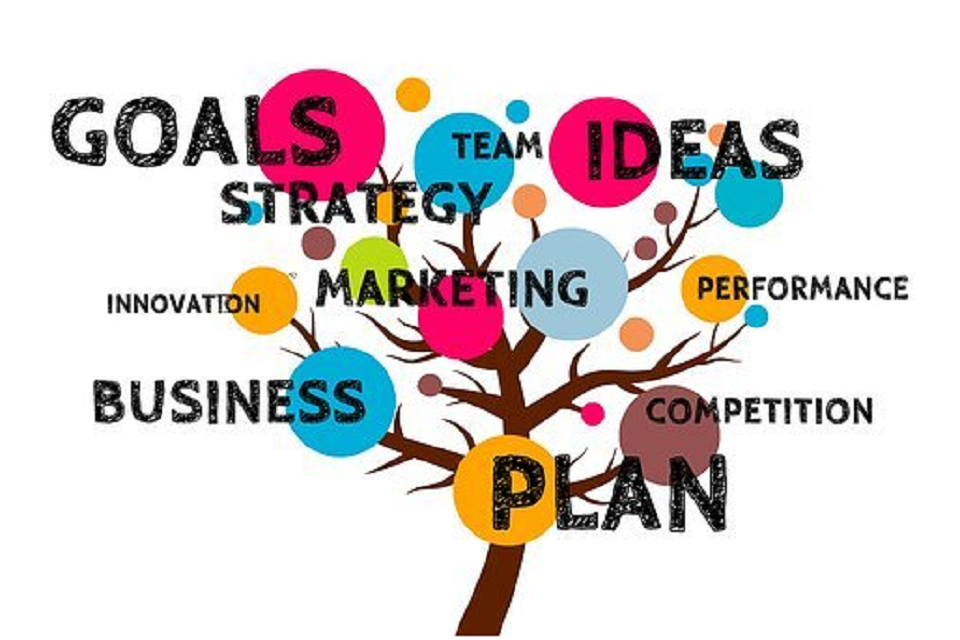
Question: What do you understand by an assignment on business management? Are there any tips which can help to write a business management assignment? List some of the business management topics for assignment writing.
Understanding the concept of assignment on business management The academic curriculum is packed with unknown subjects, discouraging the students and making them lost.Writing their first assignment is one of the toughest jobs for students, so a small help makes them feel good.If you are a business management student and have an assignment on business management, you have come to the right place for help.Business management beginners are unfamiliar with the subject, or how it is distinct from business administration, etc. They face too many challenges and try to look for help from every corner. The blog on quick guide to writing an assignment on business management will describe the fundamentals of business management and some topics related to the subject that can help you write a perfect essay.
To be clearer, it can be stated that business management is an activity involving planning, organizing, managing and controlling the resources used by the organization to attain its objectives. Business management concentrates on the comprehensive process of the organization. On the other hand, business administration concentrates on the organization’s daily operations.
To run a successful business, it is vital to manage it in business management. A business manager’s job is to make strategic decisions, assign resources, ensure the organization reaches its business goals, and hire the finest recruits. An assignment on business management helps students showcase their capability to put in theoretical knowledge on real-life situations and prepare themselves for future challenges.The subject explores different topics which can perplex even experienced students.The topics for assignment on business managementcan range from operations management to organizational behavior to financial and human resources management, etc. In the upcoming sections of this blog on quick guide to writing an assignment on business management, you will come across handy tips, standard structure, and a common outline of an essay on business management. Subsequently, we will list certain topics for your next assignment on business management. The college essay writing services from TotalAssignment.com can help you with a business essay that meets your university standards.
Handy tips to compose an assignment on business management
Though the structure of an essay and a general outline for an assignment may seem similar to you, several vital details still make them apart. These intricate details must be considered when writing an assignment on business management. The custom essay writing service from TotalAssignment.com can also help you with your essay if you have less time. You just need to inform us about your pending assignments; our assignment writers will make them for you for comprehensive assignments. It’s time we move forward to discussing the handy tips for writing an assignment on business management. The points discussed here will save you from researching how to attract the readers’ attention towards your assignment.Furthermore, adhering to the tips will make you achieve success in all your business management assignments. Select a relevant topic: While searching for your essay’s relevant business management topic, begin with a generalized approach and subsequently narrow it down to specific topics. Ponder over the areas where you hold a command and try to establish a link with the assignment.A topic with which you can relate can help you develop a quality and relevant academic paper and make the writing process much easier. Do think about your audience before selecting a topic for your assignment on business management, as this strategy will help maintain their connection and attention. Upgrade your knowledge by checking over the latest developments in the business management field so that you can select a relevant topic. Try to provide different perspectives on relatively new and significant topics, as bridging the gap will make your assignment distinct.Being specific about a topic is a good approach as it will make things more manageable and focused. Selecting a broad topic can lead to leaving out vital details related to it, whereas narrowing it down will reduce the options.
Maintain appropriate structure: Keeping up with the standard structure for an assignment on business management is vital.Be cautious to keep the ideas organized and the assignment paper, easy to follow.Clear communication with the readers about the ideas connected with the paper is an important aspect whether you are writing an assignment on organizational structure or on international business management.Begin by reading thecourse guidelines and try to understand each component. The course guidelines generally have a rough structure, format and length of the assignments.At the outset, outline to be on track and to organize your ideas coherently. Make use of headings and sub-headings to provide clarity in your assignment on business management. Begin the assignment by writing an informative introduction including a thesis statement.The other sections of the assignment will follow the introduction in different paragraphs. In these paragraphs, you can include various arguments from scholars to establish your point and help readers understand the problem discussed in the business management assignment. Employ transitional words and phrases to make a connection between paragraphs.At the end of the assignment, write a solid conclusion that links the entire assignment content.Adhering to these details will make your assignment coherent and organized. A well-structured essay is easy to follow and gets a positive response from the readers.
Avoid repetition of arguments: If you are writing an assignment for the first time, you might not know the writing style.Students, most of the time, repeat the same arguments thinking it would have more impact, but the fact is, repeating the same or similar facts in different words will make the work unprofessional.Avoiding repetition may be difficult, but there are means to do so.You can write down a few points from the research conducted for the assignment on business managementand expand each point in different paragraphs.The outline will also help create a point for each element to be included in the paper. Prioritize your points by addressing all the components of the assignment. You can also include conflicting viewpoints to make your paper of quality.
Include rationale: Like making an argument without evidence is invalid, an assignment without a rationale is inappropriate. The paper must mention the rationale behind writing an essay or an assignment.An essay must have both rationale and evidence throughout the paper. Both these elements give the effect of strong research capabilities, and to write a well-reasoned essay, it is vital to include both. It shows the efforts put in by the writer and helps to persuade the reader about the validity of the arguments and the reasons behind them. When you can explain the reason behind making an argument, you make a great opposing argument. Critical thinking is a vital aspect of the writing process. Writing research-based assignment on business management can be time-consuming, so you can hire our custom research paper writing service.The research scholars present in our team will always help you.
Adopt formal language: Maintaining professional language and tone is necessary when writing a professional article or an assignment as part of the academic curriculum. It must strictly follow the rules of grammar, vocabulary and tone. With the help of formal language, the writers can maintain a formal tone throughout the paper and make a positive impression on the audience.The writer can increase the clarity of the paper by keeping a formal tone in the paper.It will assist in avoiding confusion and ambiguity in the paper.Despite the topic, keeping a respectful association with the readers is vital. Using correct vocabulary and formal language will take you a long way in the field of writing and demonstrate your respect towards the topic and the readers. Therefore, unsuitable tones, slang, and other unprofessional tones must be avoided in academic writing.
Topics related to business management Acquiring the skill of composing an excellent essay is half the job done, as you must look for an engaging topic.Here, you will find a complete list of business management topics for your next essay. The topics are related to different business management areas, from operations to business process management. Therefore, you can select the one that excites you and begin writing the essay by referring to the knowledge imparted in the previous sections of this blog on a quick guide to writing an assignment on business management.
Topics linked to internal business management The business management writers of our organization have collected 20 winning topics for your next internal business management assignment. Traverse the list and select one of the engaging topics for your next assignment on business management.
1. Investigating management ideas in international business 2. Difficulties in attaining organizational goals concerning cross-cultural challenges 3. Challenges facing first lime managers in an international setting 4. Crucial strategies for effectively handling international business operations 5. Adopting efficient human resource strategies in the business to maximize international success 6. Handling global business threats by way of managing cultural intelligence 7. Appropriate leadership strategies for managing international business operations 8. Managing international business through effective cross-cultural communication 9. The connection between international business success and satisfied employees 10. Augmenting global performance through effective international staffing strategies 11. Capitalizing on different resources for competitive advantage 12. Comprehending the global circumstances leading to cross-cultural challenges 13. Risks in international business and the significance of foreign direct investment 14. Sustainability in managing international business 15. Threats to corporate governance in the international arena 16. Significance of ethics in international business 17. Building cross-cultural competence across international branches 18. Handling the universal value chain by engaging in different activities 19. Significance of cultural awareness in managing business internationally 20. Significance of being self-reliant for carrying out international business management
Topics linked to operations management The topics mentioned below can be used in an assignment on business management linked with operations. 1. Improving organizational performance with the help of efficient managerial skills and operations management 2. The use of organizational charts in efficient operations management 3. The influence of the administrative role on operations management 4. Attaining success at a shareholder meeting through effective operation management strategies 5. The significance of comprehending human nature in operations management 6. Making good use of consumer perception linked with market research 7. Multiplying group discourse in operation management 8. The strategies and leadership of the general manager for operations management 9. Effectively managing best practices for operations management 10. Understanding the tools, techniques and methods required to operate an organization 11. Operations management strategies to manage an organization smoothly 12. The value of operations management for organizational growth 13. Using simple forms and processes to attain productivity and efficiency 14. Significance of self-decision-making in operations management 15. Using management theories to make an effective plan for organizational development 16. Maximum utilization of human resources for the betterment of the organizational process 17. Essential strategies for streamlining the process of operations management 18. Significance of operations management for making plans and taking actions 19. Strategies for leaders for making guidelines for upper management 20. Positioning technology and human beings for better organizational performance
Topics linked to business process management Look at the top business process management topics to take the idea for your next assignment on business management. 1. Business process modeling through the aid of visual representation of a business process using tools such as flowcharts, process maps, and diagrams 2. Automating daily tasks and processes to lessen manual labor, remove errors, and increase productivity 3. Monitoring business processes in real-time, measuring their performance against key metrics, and taking corrective actions when necessary 4. Identifying improvement areas in existing business processes and redesigning them to improve performance 5. Developing policies and procedures governing business process governance 6. Using artificial intelligence and machine learning to develop business processes 7. Continuously analyzing, optimizing, and refining business processes to achieve ever-higher levels of efficiency and effectiveness 8. Managing organizational change, including the implementation of new business processes and systems 9. Developing new and innovative ways of managing and improving business processes 10. Conducting business process innovation using emerging technologies and methodologies such as Lean, Six Sigma, and Agile 11. Significance of process mapping in business process management 12. The pros and cons of using workflow automation in business processes 13. Key principles and best practices for process reengineering 14. The influence of process improvement on employee morale and job satisfaction 15. The key consideration for success in implementing a change management process 16. Value of enterprise architecture in business process management 17. Adopting fundamental principles for attaining operational success 18. Determining the journey of business process management by applying management theories 19. Using agile methodologies to improve the business process 20. The effect of business process management on building a customer base
Additional topics linked to business Here is a list of additional topics from different fields using which you can make an intriguing assignment on business management. 1. Calculating return of interest employing techniques to demonstrate value to stakeholders 2. Implementing and adopting effective change management strategies 3. Using digital transformation in business process 4. Overcoming business crises by adopting effective strategies 5. Steps to promote social responsibility and reduce environmental impact 6. Adopting emerging trends and best practices for building online branding 7. Steps to create a culture of creativity through innovation 8. Handling human resources in low-budgeted businesses 9. Taking action for handling cash flow, investment and budgets 10. Evaluating market research to manage business 11. Making use of game mechanics to enhance employee engagement 12. Taking action to manage time and prioritizing work 13. Accomplishing business deals by using strategies and tactics 14. Adopting technological advancements to monitor remote business processes 15. Best practices for improving productivity and reducing stress 16. Enforcing a healthy workplace culturefor the smooth working environment 17. Relation between human behavior and business decision making 18. Role of servant leadership for efficient business management 19. Tools to counter challenges and uncertainties in a business 20. Significance of creativity and entrepreneurial mindset in business
Advanced academic help Do you have an assignment on business management with a complex topic? Are you struggling to choose a topic for your next assignment on business management? We hope that our blog will help you to address your problems related to business management studies. Our writing services offer an exhaustive list of essay titles covering various subjects. By having our services around, you need to stress yourself about any topic related to business management or chemistry. So reach out to us today, and benefit from our trustworthy and reasonable assignment writing services.
Total Assignment Help Incase, you are looking for an opportunity to work from home and earn big money. TotalAssignmenthelp Affiliate program is the best choice for you.
Do visit : https://www.totalassignment.com/affiliate-program for more details
Total Assignment help is an assignment help Online service available in 9 countries. Our local operations span across Australia, US, UK, South east Asia and the Middle East. With extensive experience in academic writing, Total assignment help has a strong track record delivering quality writing at a nominal price that meet the unique needs of students in our local markets.
We have specialized network of highly trained writers, who can provide best possible assignment help solution for all your needs. Next time you are looking for assignment help, make sure to give us a try.
Looking for Assignment Help from Top Experts ?
Get the best Assignment Help from leading experts from the field of academics with assured onetime, 100% plagiarism free and top Quality delivery.
Related posts
Understanding the difference between basic vs applied research with the aid of examples.

Examining How To Write The Perfect Hook For Your Assignment

Get Expert Advice On How To Develop Yourself As A Human Resource Practitioner
Leave a reply cancel reply.
Your email address will not be published. Required fields are marked *
Save my name, email, and website in this browser for the next time I comment.
Instant Assignment Help on All Subjects - Get Upto 50% Off Order Now
Business Management Assignment Sample - A Learning Guide

April 12, 2019
The Ultimate Essay, and Interesting Topics yours with Examples
No 1 Assignment Help is only a click away.
Get assignments quote in 15 min..
- Australia(+61)
- United States America(+1)
- United Kingdom(+44)
- Russian Federation(+7)
- Germany(+49)
- Hong kong(+8)
- Ireland(+353)
- Jordan(+962)
- Kenya(+254)
- Malaysia(+60)
- New zealand(+64)
- Nigeria(+234)
- Pakistan(+92)
- Saudi Arabia(+966)
- Singapore(+65)
- South Africa(+27)
- Sweden(+46)
- United Arab Emirates(+971)
Let us tell you what we have got in store for you!
Ever Written Assignment On Business Case Analysis? See How It Looks!
There are a lot of parameters which needs to be dealt with while writing business management assignments. Let us talk about one of those in this section. One of the most crucial factors for the development of any business is Knowledge Transfer .
Even while you analyse a business case, you would require to see how knowledge gets transferred in that particular organisation. Let us have a look at a business management assignment sample on knowledge transfer and you will get a fair idea of what we are talking about.
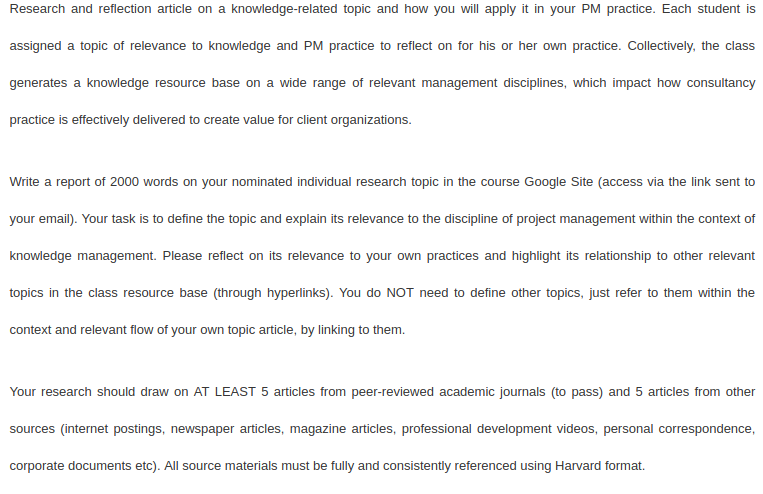
So, before we go on giving you the business management assignment sample that you have been searching for, the experts of our management assignment help services would like to brief you on how to approach this assessment. As discussed above, knowledge transfer plays an important role in regulating the progress of any organisation. Thus, this is one of the business management assessments questions which our management assignment helpers got.
For this answer, we followed a specific format while writing. First, we studied a lot of management case study assignment examples that helped us know the various ways by which knowledge can be transferred in different firms. When we had all the information, our management help providers segregated the entire solution into various sections. This included the introduction, threats to the process of knowledge transfer, various practices of knowledge transfer process, an example depicting the process of transferring knowledge and the conclusion.
This was just a brief of how our management assignment experts approached this assignment. Though knowledge transfer is just one aspect in such assignments, we have been helping students with many other such business management assignment sample that talk about the other parameters crucial for any business such as innovation.
What Next? Wait a Moment For The Business Management Assignment Solution
We know if we straight-away provide the solution, you would pay no heed to the tips that our management assignment makers have got in store for you. Thus, we thought of sharing the tips first with you and then go on to give you the solution for the discussed question.
For doing a flawless business management assignment, you just need to follow these tips -
- Make sure that your assignment includes a clear underlying theme. This would enable you put forth your ideas clearly.
- Have a strong command over the concepts which seem to be vital in your assignment. This would help you write better assignments.
- Be confident about what you write, even if you have relied upon a credible source of information for it.
Time For The Business Management Assignment Sample Solution Now!
Now that you know how to approach such assignments and what tips to follow, we feel this is the most appropriate time for us to share our intricately designed business management assignment sample solution with you. So, go ahead and check if it caters to all your requirements or not.
If it does, then you would definitely want us to guide you more on such assignments. For more such samples, click here . If not, then let us know all your requirements and we can customise this solution according to your needs.
Download Free Sample
Whatever be the case, make sure to let us know as we value each and every feedback of our clients and work upon them to improve our services.
Hand Over The Task To Our Management Assignment Experts!
Get your assignments done at warp-speed. get 50% off too order now, leave a reply cancel reply.
Your email address will not be published. Required fields are marked *
Comment Please enter your comment
Name * Please enter your name
Email * Please enter your email
Post Comment
Related Blogs

April 10, 2024
What is henri fayol's administrative management theory.

Business Research Methods Assignment Topics & Sample

What is Contingency Management Theory?

What are McGregor's Theory X and Theory Y?
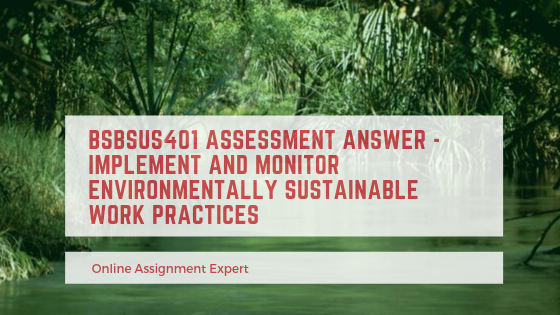
BSBSUS401 Assessment Answer - Implement And Monitor Environmentally Sustainable Work Practices

SITXMGT002 Establish and Conduct Business Relationships Assessment Answer
Subscribe our newsletter & get information about latest courses.

An Introduction to Management
An Introduction to Management
raditionally, the term “management” refers to the activities (and often the group of people) involved in the four general functions: planning, organizing, leading and coordinating of resources. Note that the four functions recur throughout the organization and are highly integrated. Emerging trends in management include assertions that leading is different than managing, and that the nature of how the four functions are carried out must change to accommodate a “new paradigm” in management. Managers at different levels of the organizational hierarchy should thoroughly understand each of the basic functions planning; organizing, leading and controlling that comprise their jobs. They should also recognize that while each is important in its own right, effective managers are skilled in performing each function, must be capable of moving back and forth among the functions as circumstances warrant, and must often juggle multiple functions and activities simultaneously. Managers cannot afford to be effective in performing only some of the functions because all are important. Few managers have equally strong skills in all areas. However, it is very useful for managers to understand their own strength and weaknesses if they want to achieve the organizational goals successfully.
Analyzing the Five forces
Supply chain of square pharmaceuticals company, define and discuss on business consulting, academic discipline, time for a new password, socially responsible marketing, request letter for change attention name on document, writ jurisdiction, analysis of seismic noise may aid in monitoring potential risks in an active mine, the last known member of the amazon tribe has died, latest post, mid-ocean ridge (mor), harnessing hydrogen at the genesis of life, ngc 5728’s faint characteristics are exposed, astronomers discover the oldest black hole ever observed, atomic hydrogen welding, variable-frequency transformer (vft).
- Study Guides
- Homework Questions
Module 2 Assignment

IMAGES
VIDEO
COMMENTS
Business management involves the supervision, organisation and coordination of business resources and operations to achieve specific objectives. A business manager has a wide range of responsibilities and daily duties that need to be performed to ensure the overall health of the business and its projects, cash flow and team members.In this, we explore the introduction to business management in ...
Assignment: Price Inelasticity of Demand. Discussion: Supply and Demand in Your Life. Module 3: Global Environment. Assignment: Taking Salty Pawz to the Global Market. Discussion: Sending Salty Pawz Global. Assignment: We Do It Better Here. Discussion: Made in America. Module 4: Financial Markets and System. Assignment: Show Wanda the Money.
Lecture Notes: 20MCA182 Business Management - M#1 ©SSM : Department of MCA, Nehru College of Engg. And Research Centre P a g e | 2 1) Effective utilisation of resources. Management tries to make effective utilisation of various resources. The resources are scarce in nature and to meet the demand of the society, their
A business management assignment helps students demonstrate their ability to apply theoretical knowledge to real scenarios and prepare them for future challenges. While the structure of the assignment is not foreign to experienced students, it covers a wide range of topics. ... Start with a strong introduction and an easy-to-digest thesis ...
Organization skills time management. Doing main tasks. Research skills Online use. Library skills (reading skill) Numeracy handling data. accounting. Set time limit to each task. assignments. Forex trade stock investigation. 8. 8. 6. 10. 8. 6. By managing projects and people, you may play the role of a successful leader.
BUS101: Introduction to Business. Learn new skills or earn credit towards a degree at your own pace with no deadlines, using free courses from Saylor Academy. Join the 1,839,519 students that started their journey with us. We're committed to removing barriers to education and helping you build essential skills to advance your career goals.
Module 1: Introduction to Management. Assignment: Evaluating Sun City Boards. Assignment: Primary Functions of Management. Module 2: History of Management. Assignment: Sun City Boards' Management Style. Assignment: History of Management. Module 3: Planning and Mission. Assignment: Creating a Plan for Sun City Boards.
Download this book. Principles of Management teaches management principles to tomorrow's business leaders by weaving three threads through every chapter: strategy, entrepreneurship and active leadership. For questions about this textbook please contact [email protected]. Creative Commons Attribution NonCommercial ShareAlike.
1) Give you a basic understanding of management and its importance. 2) Provide a foundation of the managerial functions of planning, organizing, leading, and controlling. Introduction to Management. Management is not a hard science. Unlike chemistry or algebra where a right answer (often) exists, management is fluid, and subjective, and there ...
Our mission is to improve educational access and learning for everyone. OpenStax is part of Rice University, which is a 501 (c) (3) nonprofit. Give today and help us reach more students. Help. OpenStax. This free textbook is an OpenStax resource written to increase student access to high-quality, peer-reviewed learning materials.
Module 1: Introduction to Management. Assignment: Primary Functions of Management. Discussion: The Importance of "Why". Module 2: History of Management. Assignment: History of Management. Discussion: How the Past Influences the Present. Module 3: Planning and Mission. Assignment: Creating a Plan for Sun City Boards.
7. Spend Time Reading the Materials You've Collected. Don't immediately start writing when you finish your homework; read everything carefully before you write anything to make sure that all information is correct and relevant. This will also give you an idea of what points should be included in your assignment. 8.
The exercise blends discussion on effective CRM, best management practices, marketing follow-up and effective business communication. Before Class: Have students read chapter 11 on building customer relationships, complete MindTap assignments and think about a business that they continue to frequent because of great customer relationship ...
MBA Micro Group Assignment for Economics for Business EFB911M[1894][2100] 12 pages 2021/2022 None. 2021/2022 None. Save. Cumlaude SOM Report - none; SOM Individual Assignment; ... Introduction to Business Management (BMI511S) 2 months ago. determine the future value of an amount of N$ 25 000, invested for 7 years, which is earning 7% interest.
Practice materials None. 3. Intro to BMG Units 1 - 4 classwork answers. Lecture notes 82% (11) 3. Intro to BMG UNIT 2 Classwork answers 2021. Lecture notes 89% (9) 100. Introduction to Business Management.
Introduction to Business Management Assignment 02 - Free download as PDF File (.pdf), Text File (.txt) or read online for free. lesson 4
Make use of headings and sub-headings to provide clarity in your assignment on business management. Begin the assignment by writing an informative introduction including a thesis statement.The other sections of the assignment will follow the introduction in different paragraphs. In these paragraphs, you can include various arguments from ...
This included the introduction, threats to the process of knowledge transfer, various practices of knowledge transfer process, an example depicting the process of transferring knowledge and the conclusion. ... For doing a flawless business management assignment, you just need to follow these tips - Make sure that your assignment includes a ...
Assignment. An Introduction to Management. T. raditionally, the term "management" refers to the activities (and often the group of people) involved in the four general functions: planning, organizing, leading and coordinating of resources. Note that the four functions recur throughout the organization and are highly integrated.
BUSINESS MANAGEMENT 1 question one with the aid of examples related to the case study above, discuss the primary activities of value chain. the primary ... Business Management Assignment. Course: Introduction to business management (CBMA 011) 145 Documents. Students shared 145 documents in this course.
Assignment 1: Databases and Database Development | MIS 4340. Foundations of Database System Development - Homework 1 | MIS 4340. Clinical Case Study - Secondary Reading and Writing | READ 6255. Logical Database Design - Assignment 3 | MIS 4340. Assignment 4 for Foundations of Database System Development | MIS 4340.
Higher Diploma in Business Management Assignment Cover Sheet Qualification Module Number and Title HD in Business Management SRI 4151: Introduction to Management Student Name & No. Assessor Name: Student No: HD BM 91 Ms. Amandi Kulasinghe Handover date Submission Date 07/02/2021 Assessment type Duration/Length of Assessment Type Weighting of ...
2. Assignment 1 Question. Practice materials 100% (1) 4. Exam 1 June 2018, Questions - Business Management Bma1A01 Final. Practice materials 81% (95) 14. Test 1 - Memo - BB - summative test 1 for semester 1 2022 with memo Business management 1A. Other 100% (6)
Business. Evelyn Lungu Assignment 2 GBS 614 / Risk Management February 2024 Dr. Raj Parikh 05 th March, 2024. Introduction For almost 50 years now, project management was viewed as a process that might be nice to practice or have but not necessarily for the survival of organizations or companies. Before, company reluctantly invested in training ...